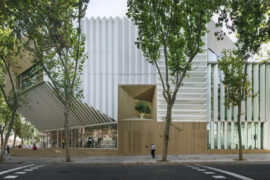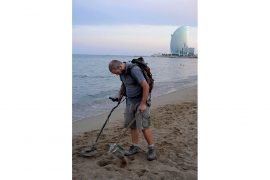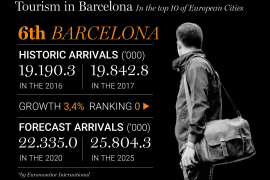[dropcap letter=”I”]
n Lleida, there is a popular saying that goes that claims that the city only has three “stations” (which translates as “stations” and “seasons”, in Catalan): winter, summer and the train station. This is a recurrent joke intended to bring humour to climate rigours of the capital of this westernmost region of Catalonia. We could summarize it as follows: freezing in winter –and if the fog sets in, you will to chill to the bone and even to your dreams!–; in summer, it is a real scorcher, there is nowhere to hide from the heat. There is no middle ground. Therefore, the third “station” (“season” in Catalan) that Lleida can claim is that of the train station. And it is no mere station. Lleida’s train station is a landmark building dating back to 1927 and has almost nothing to envy to Estació de França in Barcelona or the one in Portbou, to name just two of the most iconic stations on account of its architectural elegance, with its French neoclassical touch (when it comes to assessing its train services, it is another kettle of fish).
Curiously enough, this is one of the few Catalan stations hosting two different providers, that of Renfe and that of Ferrocarrils de la Generalitat
From 2003, when the high-speed train between Lleida and Madrid was inaugurated, the station of the Segrià’s capital city was granted the name of Lleida-Pirineus station. Apart from the high-speed train between Camp de Tarragona and Barcelona, this is where the service between Barcelona and Manresa (the train reached Lleida from that region, back in 1860) and the service between Lleida and Pobla de Segur (formerly, the service to Balaguer was first operated in 1924, and 25 years later the service was extended to Pobla). Curiously enough, this is one of the few Catalan stations hosting two different providers, that of Renfe and that of Ferrocarrils de la Generalitat. All this background has turned the Lleida station, situated in a highly privileged and relatively centric enclave, by the river Segre, on the boundary between the historical centre and the area opening up to the city, into a transit point for all types of people.
A much-sought place for the passer-by –here the name is no misnomer– is the train or the train destination or the evening or tomorrow’s ups-and-downs. The station square embodies perfectly the hustle and bustle of today’s individual: in fact, we are not where we are
A train station square –in this collection dedicated to visiting the country’s squares, we had never stopped on this typology!–, a train station square, I was saying, is by definition, a mere transit point, a charmless and unfunny location, a place of hustle and bustle, where, in general, people are always late. Even someone waiting for a passenger adopts the air of having waited for some time, of giving anxious glances at one’s watch because the train has just arrived or is about to leave.
 Despite an attempt of planting a few benches all around the square of the Lleida train station –and a few scattered trees–, this does not seem to be a place to stay. A much-sought place for the passer-by –here the name is no misnomer– is the train or the train destination or the evening or tomorrow’s ups-and-downs. The station square embodies perfectly the hustle and bustle of today’s individual: in fact, we are not where we are, we are not from where we stand because we would like to be somewhere else, and we regret leaving a place we leave behind. The square is a transient ungrateful place to God knows what. As we observe these endless flows of people, we can come to a few curious conclusions on the traveller’s profile, a picturesque melange. Rarely does our ecosystem mingle in a more diverse plot of land. In the morning, it is the students’ turn. In the evening, executives. From the high-street train from Madrid they appear slightly bowed, suitcase in hand firmly determined to do business, attend a congress or other such issues. If the train comes from Seville, its passengers are likely to come to visit relatives. In the case of the Avant train from Barcelona and Tarragona –a regional train, cheaper than the more expensive high-speed train– we will see students and workers. From the regional train to Pobla de Segur, we are more likely to see college students and old ladies with no driving licenses. During the ski season, many of the passengers in the high-speed train will go to the Pyrenees and complete the final edge of this communication bundle –unfortunately, often forgotten– of Lleida.
Despite an attempt of planting a few benches all around the square of the Lleida train station –and a few scattered trees–, this does not seem to be a place to stay. A much-sought place for the passer-by –here the name is no misnomer– is the train or the train destination or the evening or tomorrow’s ups-and-downs. The station square embodies perfectly the hustle and bustle of today’s individual: in fact, we are not where we are, we are not from where we stand because we would like to be somewhere else, and we regret leaving a place we leave behind. The square is a transient ungrateful place to God knows what. As we observe these endless flows of people, we can come to a few curious conclusions on the traveller’s profile, a picturesque melange. Rarely does our ecosystem mingle in a more diverse plot of land. In the morning, it is the students’ turn. In the evening, executives. From the high-street train from Madrid they appear slightly bowed, suitcase in hand firmly determined to do business, attend a congress or other such issues. If the train comes from Seville, its passengers are likely to come to visit relatives. In the case of the Avant train from Barcelona and Tarragona –a regional train, cheaper than the more expensive high-speed train– we will see students and workers. From the regional train to Pobla de Segur, we are more likely to see college students and old ladies with no driving licenses. During the ski season, many of the passengers in the high-speed train will go to the Pyrenees and complete the final edge of this communication bundle –unfortunately, often forgotten– of Lleida.
A young couple –possibly students– seems to delay their entry to the station. Now a joke, now a laugh, alien to the train season schedule, be that winter or summer. They seem to have all the time in the world.
Some of the passengers arrived recently will head for the station’s car park. Above it, behind a wire mesh, we can see a skeletal forest of column wires, planted in a concrete flower pot. This is the aesthetically imaginative structure adopted by the foundations laid out for a possible future commercial centre. A friend tells me this is, again, a much-talked about issue, that maybe they will do it this time. Actually, the square opposite the station can also symbolise impatient waits, and a feeling of fruitless trainspotting. And then, a whole raft of small decisions take place, and despite being routine actions, they are relevant all the same. The restaurant to have a meal, a city map, I want to go first to Seu Vella, how about walking by the river, look here’s a tourist office…
A group of pensioners gather around, as they leave the station, and try to agree on where to go next.
–Let’s walk around a bit before lunch, it’s too early for lunch anyway.
Three Moroccan youngsters embrace their families, who came to the station to welcome them. The mother shines as she looks at them while the father rushes them to get into the car.
A young couple –possibly students– seems to delay their entry to the station. Now a joke, now a laugh, alien to the train season schedule, be that winter or summer. They seem to have all the time in the world.



















